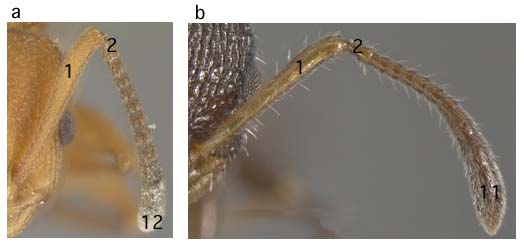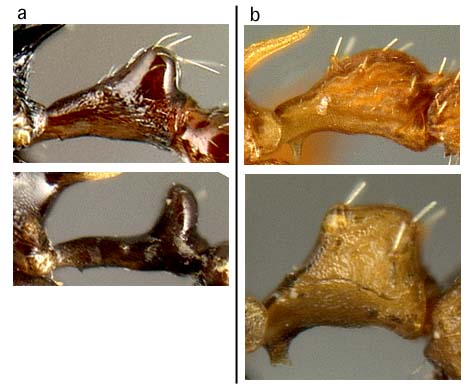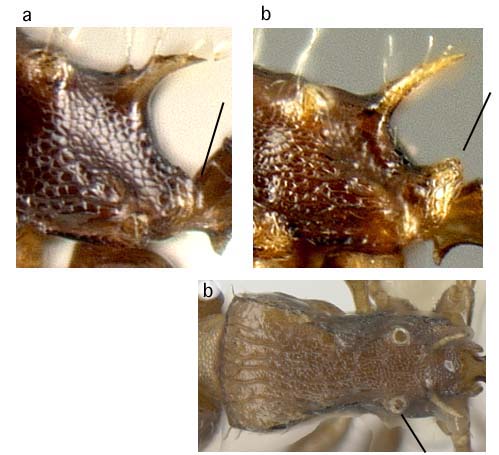| Genus List | Species List | Genus Overview |
These two genera have traditionally both been placed in Leptothorax. Leptothorax was divided into three genera by Bolton (2003): Leptothorax s.s., Nesomyrmex and Temnothorax. Leptothorax is north temperate and does not occur in Costa Rica. In Nesomyrmex, the median portion of the clypeus anteriorly forms a prominent lobe that overlaps and is closely applied to the mandibular dorsum, and in profile view the anterior clypeus overlaps and is closely adherent to the dorsal surface of mandible. In Temnothorax, the median portion of the clypeus does not form an anteriorly projecting lobe, and in profile view the anterior margin is usually elevated slightly away from the dorsal surface of mandible.
These are otherwise similar ants, and I previously keyed them together under Leptothorax. I continue to key them together here.

10a. Antennae 12-segmented: 20
10b. Antennae 11-segmented: 50

20a. Petiolar peduncle as long as or longer then node (Temnothorax, former macromischa group of Leptothorax): 30
20b. Petiolar peduncle shorter than node: 40

30a. Looks like a: Temnothorax subditivus
30b. Looks like b: Temnothorax salvini
30c. Looks like c: Temnothorax JTL-006
30d. Looks like d: Temnothorax JTL-007

40a. Looks like a: Nesomyrmex anduzei
40b. Looks like b: Nesomyrmex pittieri
40c. Looks like c: Nesomyrmex JTL-005
40d. Looks like d: Nesomyrmex tonsuratus

50a. Face and sides of thorax coarsely rugose: Nesomyrmex asper
50b. Face shallowly etched and punctate to smooth and shiny; sides of thorax feebly rugose to smooth and shiny: 60

60a. Metasternal lobes rounded; propodeal spiracles directed posteriorly, not highly visible in dorsal view; propodeal dorsum punctate, not smooth and shiny: Nesomyrmex echinatinodis complex
60b. Without the above combination of characters; metasternal lobes usually subangulate but may be rounded, if rounded then propodeal dorsum smooth and shiny; propodeal spiracles directed upward, highly visible in dorsal view: 70

70a. Sides of thorax punctate; metasternal lobes subangulate: Nesomyrmex pleuriticus
70b. Sides of thorax shining; metasternal lobes subangulate or rounded: 80

80a. Metasternal lobes subangulate; sides of propodeum with a few coarse rugae; propodeal spines relatively large; petiolar node relatively elongate and low: Nesomyrmex vargasi
80b. Metasternal lobes subangulate or rounded; sides of propodeum almost completely smooth; propodeal spines relatively smaller; petiolar node relatively shorter and taller: Nesomyrmex JTL-009
Literature Cited
Bolton, B. 2003. Synopsis and classification of Formicidae. Mem. Amer. Entomol. Inst. 71:1-370.
Page author:
John T. Longino, The Evergreen State College, Olympia WA 98505 USA.longinoj@evergreen.edu